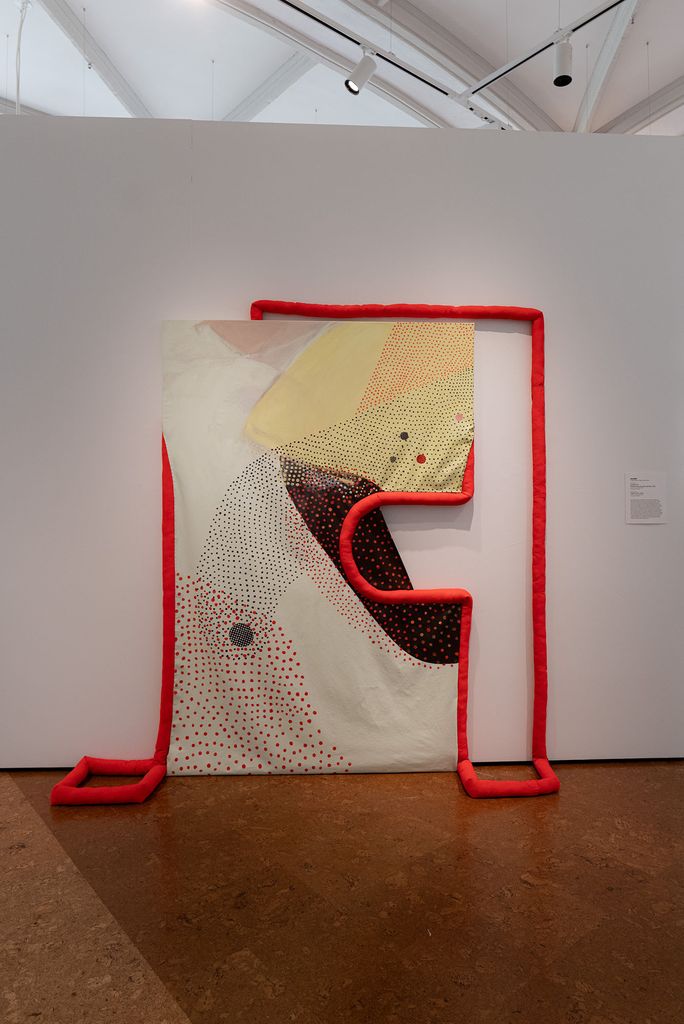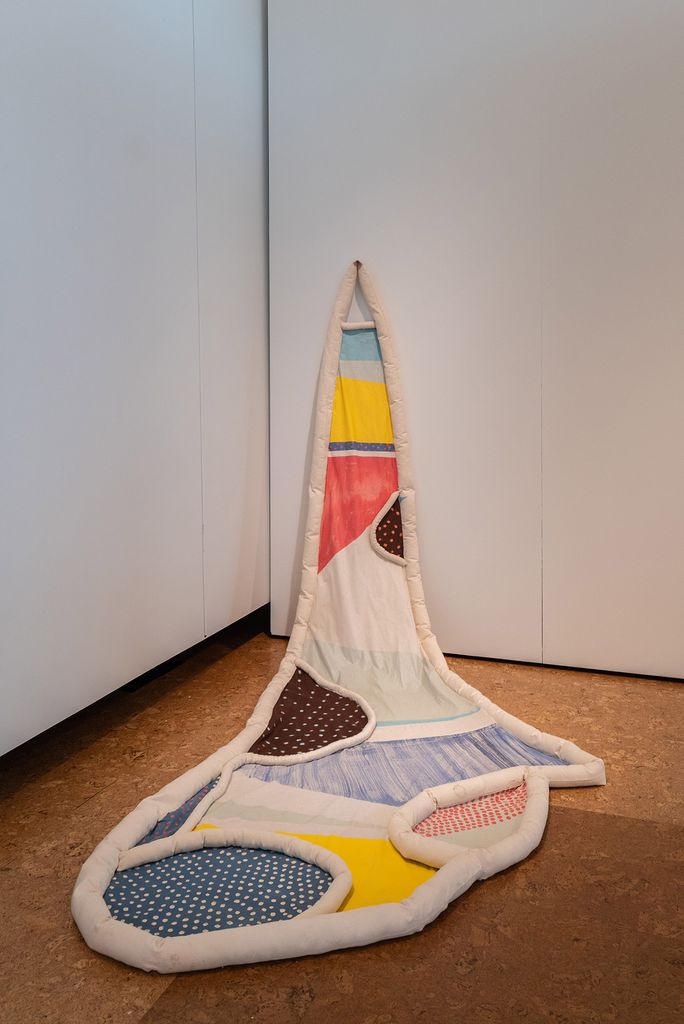Stone Gallery Exhibition STUFFED Highlights the Subversive Side of Fiber Arts

Ballet Bag (2021), a 2021 soft sculpture by Rose Nestler, one of 13 contemporary artists whose work is featured in STUFFED, an exhibition of 3D fiber arts on view at the Faye G., Jo, and James Stone Gallery through September 15.
Stone Gallery Exhibition STUFFED Highlights the Subversive Side of Fiber Arts
Features works by 13 female artists who are using pliable materials in new ways
The new exhibition at the Faye G., Jo, and James Stone Gallery might make you feel like curling up with a good book and a cup of hot cocoa. That would be a mistake.
STUFFED seeks to disassociate soft, plush objects from the realm of the familiar and comfortable and recast them as sophisticated, rebellious—even sexy.
The group show, on view through September 15, is a collection of three-dimensional fiber artworks—or soft sculptures—organized by Boston-based curators Mallory Ruymann and Leah Triplett-Harrington, a writer, editor and frequent College of Fine Arts collaborator.
“I hope this exhibition helps people consider how textiles and fabrics influence our everyday lives,” says Triplett-Harrington. She and Ruymann have collaborated on previous shows.
The aesthetic choices the show’s 13 artists—all women—have made leave viewers no choice but to think beyond teddy bears and down comforters. Consider the challenging, seductive gazes on view in Maria A. Guzmán Capron’s Piedra de Mar, a quilted sculpture featuring two women literally sewn from the same cloth, sharing an intimate embrace while their eyes confront the viewer. Or how Rose Nestler’s Affordable Facelift, a wall display featuring metallic-colored tufted seat sections, resembles a grimacing, drooping face.
Comfort is not the name of the game here.
Beyond the individual aesthetics, the boldness of this exhibition, named a Boston Globe staff pick, can be seen in its broader mission: to take media often dismissed as domestic crafts—sewing, quilting, and felting—and show how they can be used to create art that defies categorization.
“Our curatorial partnership foregrounds femme, women-identifying, and gender queer artists,” Triplett-Harrington says. ”STUFFED is part of a larger project to recast and recontextualize feminist artists and art-making.”
“There is a grain of identity politics within the curatorial theme that provides a platform for discussion about gender,” Ruymann adds, “and many of the artists in the show make work explicitly about the experience of being a woman’s body.” Case in point: Courtney Stock, whose works are explicitly rooted in the context of her body. Two of her mixed-media sculptures in the exhibition—humanoid figures called mother and child—hang side by side in the gallery. Headless forms stuffed with polyester and bedecked with scraps of silk, beads, and semiprecious stones, they are inspired in part by ultrasound imagery, Stock says.


Inside Out: Redefining the Boundaries (2021) (left) and Hopscotch (2021), both fiber works by Jai Hart, a Boston-based artist whose work explores “where the boundaries exist within a painting and on the walls.”
“I had a baby in the summer of 2022, and I decided, especially with the strangeness and raw-around-the-edges-ness of my work, that it was okay to lean into an autobiographical narrative,” she explains. “It references how much I’ve learned about my body through pregnancy, and also this shift in perspective when you’re seeing your insides on a screen.”
Taking a more meta approach, Boston-based artist Jai Hart sought to subvert the constraints imposed by traditional 2D art. While her works, comprising acrylic on canvas and filled with polyester, are meant to hang on gallery walls the way a painting would, the way they slope toward the floor or defy their own borders speaks to her vision.
“How do we see frames or borders around paintings? How can preestablished boundaries be manipulated for progress?” she asks. “I hope to give my audience a different experience and have them question the way they may see traditional framing.”
Amid all the subversion happening in STUFFED, the show even occasionally subverts itself.
“We’ve snuck in a few artworks that are not actually stuffed, but carry the suggestion of fill,” Ruymann says.
The works of L’Merchie Frazier, a multi-hyphenate artist and activist, are one example. Though known for her quilts, Frazier chose to contribute two 2D works that she says are “stuffed with meaning” and incorporate weaving and machine-quilting techniques with mixed-media elements like fiber and plastic caution tape. With an eye on local and national history, her work contends with anti-Black racism and structural inequality. The idea of working with traditional handicrafts was something that appealed to her naturally.
“My grandfather was a tailor and upholsterer, and my mother told me stories about how he used to take cloth fragments and put them together to make quilts to keep his children warm at night,” Frazier says. “That was a part of the legacy that she passed on to me, and my take on it has to do with the preservation of art, culture, innovation, and history.”
Perhaps the most subversive thing about STUFFED is the material itself. Pliant and easily able to conform to an artist’s vision, it requires none of the conforming creators must make to rigid materials like canvas or stone. It can truly be anything.
“The flexibility of fiber-based art is what makes it special,” Ruymann says. “Painting, sculpture, installation—the possibilities of the medium seem endless.”
STUFFED is on view at the Faye G., Jo, and James Stone Gallery, 855 Commonwealth Ave., through September 15. The gallery is free and open to the public Tuesday through Saturday, from 11 am to 5 pm. Note: all BU art galleries will be closed from August 27 to September 4 to prepare for the new academic year. STUFFED will reopen on September 5.

Comments & Discussion
Boston University moderates comments to facilitate an informed, substantive, civil conversation. Abusive, profane, self-promotional, misleading, incoherent or off-topic comments will be rejected. Moderators are staffed during regular business hours (EST) and can only accept comments written in English. Statistics or facts must include a citation or a link to the citation.